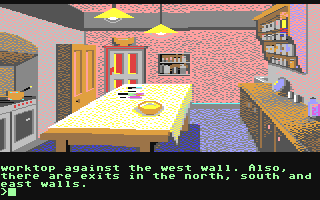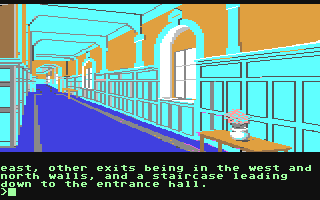|
First let's do a bit of image stripping so we can see
what the game itself is actually like. Magnetic Scrolls
leaped into the headlines last year with The Pawn
-- stupendous parser, brill graphics, interactive characters,
original scenario, new software house (well almost),
Rainbird marketing and multi-format availability.
The
last two points are very significant -- there are really
only four companies in the UK that have marketed their
games forcefully across all formats -- Adventure International
(now defunct), Adventuresoft (via US Gold), Level 9
and Melbourne House. Some might wish to include CRL,
but it only just scrapes in, as it's not a dedicated
adventure house. Magnetic Scrolls is therefore a big
fish -- albeit in a very small pool.

Secondly,
a lot of this media hype arose because of the strength
of the parser and the graphics. Journalists who would
never have been seen dead playing an adventure, suddenly
went all ga-ga because of the pretty pictures. And the
parser means that they could communicate with the game.
Therefore a whole legion of self-appointed adventure
reviewers sprung up proclaiming The Pawn to be
the best thing since sliced bread.
Meanwhile
for us dedicated adventurers the real question has yet
to be answered -- are these Magnetic Scrolls adventures
actually good games? Are they worth your £19.95, or
is 90% of the satisfaction derived from just looking
at the pretty pics and entering PUT THE IVORY KEY IN
THE SWAG BAG AND THEN DROP THE POISON ON THE STEPS.
The
Wiz sat down to play Guild of Thieves with slight
misgivings. I wondered why this was and realised to
my horror that I hadn't actually enjoyed playing The
Pawn very much. Sacrilege! But although others will
doubtless disagree, I felt that it was just a bit pretentious.
It had some great puzzles, but the scenario was a bit
odd . . . well, let's say I found it a bit -- gulp --
dull!

So
it came as quite a pleasant surprise when I found myself
getting very engrossed in Guild of Thieves. It
may not be as original or way out as some of the things
we've seen lately, but it's definitely shaping up to
be one of the Wiz's favourite games.
You
start off sitting in a boat in mid-stream with a representative
of the Guild. To gain admission to this august body
you must loot the surrounding countryside of all its
valuables. So unlike The Pawn we have here a
very traditional scenario -- the good ol' treasure hunt.
If
you're wondering why there should be anything good about
sticking to traditional themes instead of inventing
startling new plots, the answer is that the very structure
of adventure programs revolves heavily around locations
and objects. It makes sense therefore to have a scenario
that rewards the discovery of locations and objects
with good solid points! So traditionalists will note
with glee the score counter constantly displayed at
the top of the screen (together with the number of moves
you've made).

The
parser is once again magnificent. You can make a lot
of use of your good ol' swag bag: for example, PUT ALL
EXCEPT THE LAMP IN THE SWAG BAG AND CLOSE IT will execute
rapidly and without difficulty. This means that playing
the game becomes an enjoyable exercise of the imagination,
rather than a battle of misunderstood words.
As
you move about, you'll start to make use of another
feature of the parser -- the GO TO command. Once you've
visited a location or EXAMINEd an object, you can GO
TO it from another place. In the Golden Wheatfield for
example, typing GO TO TEMPLE or GO TO STATUE will take
you rapidly through the intervening locations to the
temple (where the statue is).
There
are two points to note about the GO TO command. First,
it can kill you if you're not careful. For example,
typing GO TO TEMPLE in the Lounge will take you out
of the castle by way of the drawbridge and irate door
keeper -- not a very good idea, and once you've entered
the command, you can't take it back.

Second,
it appears to GO only TO objects that you've actually
EXAMINEd. This can be misleading. Take the temple again
-- the room description says clearly that there is a
statue there, but entering GO TO STATUE later will do
you no good unless you've examined it. Apparently, seeing
it is not enough.
The
GO TO command is particularly useful when storing your
treasure. Valuables aren't that difficult to find to
start with, but the inexperienced player may wonder
why picking them up doesn't increase his/her score.
The answer is that they only register when you've put
them in one of the Bank of Kerovnia's safety deposit
boxes.
Use
of the safety deposit boxes highlights another excellent
feature of this adventure -- the game design. All of
the puzzles are wonderfully constructed -- logical,
sometimes quite difficult, and very satisfying to solve.
For example, the safes will not relinquish an article
once it's been put inside, so you have to be quite careful
about banking your treasures, making sure first that
what you have is a treasure and not something that you
will require later on.

Having
played the game on both the Commodore and the ST, I
found one aspect to be less than satisfying -- the disc
accesses. The game comes on two discs, and although
actual disc swapping is kept to a bare minimum, the
old 1541 grinds away for ages. Even Infocom disc accesses
seem quicker than these, and at tense moments I found
the delays a real annoyance.
There's
a particularly long access when the game loads in a
new graphics scene. The pics are great, but if (as with
most people) you expectations have been raised by seeing
the Atari screenshots that most other magazines printed,
then you are in for a slight disappointment. You certainly
won't find yourself complaining about the lack of illustration,
although sometimes you may find yourself wasting time
examining objects that are clearly shown in the drawings,
but don't in fact exist within the program.
Guild
of Thieves is an excellent program, combining Magnetic
Scrolls' programming expertise with a more accessible
scenario and some excellent puzzles. It should take
you a long time to finish and numerous SAVEs will be
needed. Sadly there's no RAM-save option and -- equally
annoying -- no catalogue function to enable you to check
up on previous saved filenames. However, these are minor
quibbles about a game that's destined to be a classic.
Even at £19.95 you can't go far wrong.
|